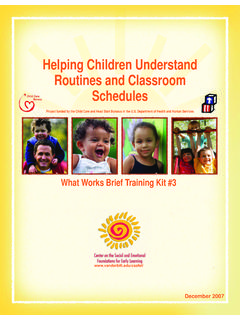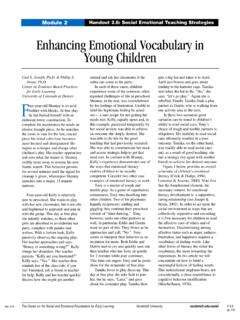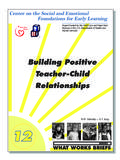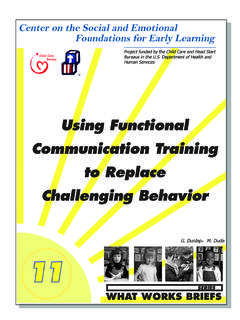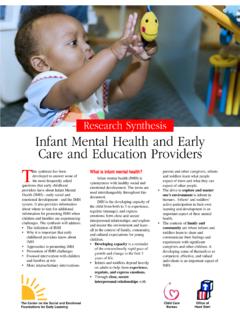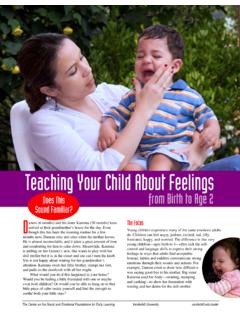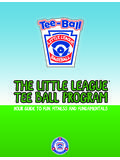Transcription of Helping Children Learn to Manage Their Own …
1 Project funded by the Child Care and Head Start Bureaus in the Department of Health and Human ServicesHelping Children Learn to Manage Their Own BehaviorWhat Works Brief Training Kit #7 March 2008 What Works Brief Training Kits were developed to help in-service and pre-service providers conduct staff development activities. Each kit is based on one What Works Brief and contains the following items: presenter s PowerPoint note pages, participant handouts, activity ideas, pre-training survey, demographic form, training evaluation, and training certificate. The What Works Brief Training Kits are grounded in the Pyramid model depicted below, which provides a framework for describing the four interrelated levels of practice that address the social and emotional development of all Children . The Pyramid is designed to guide practitioners in understanding the importance of Children s social-emotional competence in terms of school readiness and the prevention of challenging behavior.
2 This What Works Brief Training Kit relates to the Targeted Social Emotional Supports level of the Pyramid. We welcome your feedback as you provide professional development activities with these materials. Special thanks to the Meginnis Endowment at UIUC for funding to help support this effortand to the following individuals who developed the What Works Brief Training Kits materials:Micki Ostrosky, Hedda Meadan, Greg Cheatham, Monique Mills, Sallee Beneke, Nancy Gaumer, Amy Hayden, Elenor Rentschler, and Angel Notes:Presenter should be familiar with the content in What Works Brief #7 and Module 3b, Section XVI on Monitoring Outcomes for example monitoring forms available at Consider using What Works Brief #7 handout as a supplemental resource. Welcome participants. Take care of any logistics ( , length of time for session, break, handouts, etc.)
3 Pass out pre-training survey for all participants to complete and turn in if you present the workshop: Remind participants to take the culture and background of Children into consideration and to work hand-in-hand with parents when they select target behaviors, since some behaviors may be part of the child s culture. WWB Training Kit #7 Helping Children Learn to Manage Their Own BehaviorPresenter PowerPointPresenter NotesWhat Is Self-Management?Used to teach Children (four years and older) to:Pay attention to Their own behavior Use appropriate play and social interaction skills Participate in classroom routines Engage in instructional activities Speaker Notes:One way to help young Children Manage Their own behavior, allowing teachers to spend more time teaching and less time dealing with occurrences of challenging behavior, is through self-management.
4 Self-management can be used to Teach Children what is expected of them ( , tasks they are supposed to do).Keep track of whether or not Children complete these tasks. Monitor Their own behavior and control Their own actions. See Clip at for an activity that promotes understanding of appropriate behavior. Steps to Self-ManagementAssess child s current level of Identify behaviors you want the child to Learn to Visually display behavior for the Guide the child to Learn the desired behaviors and self-4. management positive attention for using the self-monitoring 5. system Notes:Review these steps with participants. Each step will be discussed in 1: Assessing the Child s AbilitiesAssess the child s current level of self-management skills by determining if the child can complete target Notes:To use self-management, teachers need to know the child s abilities.
5 Can the child complete the target behaviors we d like him/her to complete? (For example, if we want a child to independently use the toilet, we must determine if the child currently recognizes when he/she needs to use the toilet and can convey this need to a teacher.)Teachers can assess by asking the following questions about the child: Is the child able to make an accurate self-assessment of his or her behavior?What is the child s current level of self-management skills? What is it that interests or engages the child that may be used to begin a self-management program?Are there any factors or challenges before implementing a self- management plan?What goals do I have for the child and the classroom or home environment in using a self-management plan?Step 2: Identifying Target BehaviorsIdentify what observable behaviors you want the child to Learn to self- Manage .
6 Each step should clearly describe what the child should Notes:Two examples:When told to clean up, the child should stop playing, pick up toys, place them on the shelf, and take a seat in the circle told to sit quietly, the child should stop talking, sit with her hands in her lap, and look at the 3: Displaying BehaviorsVisually display the target behaviors using photographs or drawings on a poster, on a sheet of paper, or in a a way for the child to monitor his/her behavior ( , a check mark, smiley face, thumbs up/thumbs down).Speaker Notes:Example:When teaching a child to use the bathroom independently, you could draw each step on a poster or in the form of a book depicting steps such as pulling pants down, sitting on the toilet, wiping with toilet paper, pulling pants up, and washing participants if they can think of other ways to display child 4: Guiding the ChildGuide the child to Learn the desired behaviors and to use the self-management system ( , check marks, smiley faces, thumbs up/thumbs down) to assess performance of the Notes: Ideas to share about guiding the child:After preparing the charting system ( , check marks, smiley faces, thumbs up/thumbs down), the child is guided to monitor his/her performance of the behavior.
7 Teachers should review the charting system with the child prior to beginning the should also review the individual steps to accurate performance of the target behavior ( , when teaching a child to use the bathroom independently, teachers should review steps to complete this, such as pulling pants down).Step 5: Providing Positive FeedbackProvide positive attention to the child when he/she correctly completes the steps to successful completion of the target positive attention to the child when he/she correctly uses the self-monitoring system Notes:To make it more likely that the child will continue to engage in the target behavior and use the self-management system, teachers should provide specific and immediate positive feedback: Melissa, good job cleaning and marking the steps you did by yourself! Sally, I see that you have your hands in your lap, thank you for sitting so quietly.
8 Kara, nice job remembering what you did and marking the steps on your chart! Activity 1: Developing a Self-Management SystemMs. Susan asks the Children in her class to put the art supplies away, put Their creations in Their cubbies, and gather together on the rug for story time. David, a 4-year-old in her class, often leaves everything on the table and wanders around the room Notes:Ask participants to read the scenario. Then in pairs develop a self-management system for the child described in the 2 Using Self-Management in Your SettingSpeaker Notes:Assign partners. Pairs should think about ways they can use self-management in Their settings (center/school). Prompt participants to think about obstacles to using self-management as well as ways to overcome the obstacles. Share thoughts with the large group by having a few groups share Their with a partnerThink about ways to use self-management with Children in your settingShare your thoughts with the large groupAdditional ResourcesCarta, J.
9 J., Estes, J. S., Schiefelbusch, J., & Terry, B. J. (2000). Project Slide: Skills for learning independence in developmentally appropriate environments. Longmont, CO: Sopris West (available from ). Speaker Notes:Thank the participants for participating and have them complete the evaluation form, if appropriate. Distribute the certificate of attendance if appropriate. Pre-training SurveyR How can self-management be used to address Children s behavior?R What are two questions to ask in determining a child s current level of self- management? R What are two strategies to support Children s use of self-management?R What are the three most pressing issues you face as an early childhood professional?1. 2. 3. WWBTK #7: Helping Children Learn to Manage Their Own BehaviorPre-training SurveyDemographic InformationDescribe yourself (check the boxes that best describe you):R Your gender: Female MaleR Your age: under 30 31 to 40 41 to 50 51-60 61 and aboveR Your ethnicity: European American Asian-Pacific Hispanic African-American American Indian Other (specify)_____R Check your current teaching certificates: Early Childhood Education Elementary Education Special Education Other (Specify)_____R Check the one that best describes your education: High school or GED Some college Associate s degree Bachelor s degree Master s degree Other (Specify)_____R Your teaching experience:R How many year(s) have you taught preschoolers?
10 _____R How many year(s) have you taught preschoolers with IEPs?_____Thank you for completing this #7: Helping Children Learn to Manage Their Own BehaviorWWB Training Kit #7 Helping Children Learn to Manage Their Own BehaviorParticipant PowerPointWhat is Self-Management?Used to teach Children (four years and older) to:Pay attention to Their own behavior. Use appropriate play and social interaction skillsParticipate in classroom routines Engage in instructional activitiesStep 1: Assessing the Child s AbilitiesAssess the child s current level of self-management skills by determining if the child can complete target behaviors NotesParticipant NotesStep 2: Identifying Target BehaviorsIdentify what observable behaviors you want the child to Learn to self- Manage . Each step should clearly describe what the child should 3: Displaying BehaviorsVisually display the target behaviors using photographs or drawings on a poster, on a sheet of paper, or in a a way for the child to monitor his/ her behavior ( , a check mark, smiley face, thumbs up/thumbs down).
